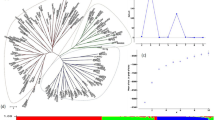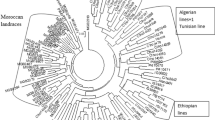Summary
Advanced agricultures are characterized by a great increase in the adoptation of uniform crop cultivars associated with a drastic reduction in locally adapted variation, the plant breeders should also examine means of creating and conserving genetic resources. Composite cross breeding is a technique that creates and preserves genetic variation in an exploitable form. The merits and problems of this method were discussed. using data obtained from barley Composite Cross XXI.
Similar content being viewed by others
References
Augus, R. F., R.Jones & J. H.Wilson, 1972. A comparison of barley cultivars with different leaf inclination. Aust. J. Agric. Res. 23(6): 945–957.
Donald, C. M., 1963. Competition among crop and pasture plants. Adv. Agron. 15: 1–118.
Donald, C. M., 1968. The breeding of crop ideotypes. Euphytica 20: 400–409.
Hamblin, J. & C. M.Donald, 1974. The relationships between plant form, competitive ability and grain yield in a barley cross. Euphytica 23: 535–542.
Jaln, S. K., 1961. Studies on the breeding of self-pollinating cereals the composite cross bulk population method. Euphytica 10: 315–324.
Jennings, P. R. & R. C.Aquino, 1968. Studies on competition in rice. III. The mechanism of competition among genotypes. Evolution 22: 529–542.
Jennings, P. R. & R. M.Herrera, 1968. Studies on competition in rice. II. Competition in segregating populations. Evolution 22: 332–336.
Johnson, L. P. V. & L. N. Singh, 1969. Natural selection in a hybrid population of barley. Proc. 2nd Int. Barley Conf. Washington.
Mumaw, C. R. & C. R.Weber, 1957. Competition and natural selection in soybean varietal composites. Agron. J. 49: 154–160.
Suneson, C. A., 1956. An evolutionary plant breeding method. Agron. Jour. 48: 188–190.
Suneson, C. A. & G. A.Wiebe, 1962. A ‘Paul Bunyan’ plant breeding enterprise with barley. Crop Sci. 12: 347–348.
Suneson, C. A., R. T.Ramage & B. J.Hoyle, 1963. Compatibility of evolutionary and mutation breeding methods. Euphytica 12: 90–92.
Tanner, J. W., C. J.Gardener, N. C.Stoskopf & E.Reinbergs, 1966. Some observations on upright leaf type small grains. Can. J. Pl. Sci. 46: 690.
Thorne, G. N., 1966. Physiological aspects of grain yield in cereals. In the growth of cereals and grasses. Butterworth, London, p. 88–105.
Udy, D. C., 1971. Improved dye method for estimating protein. J. Am. Oil Chemist' Soc. 48: 29A-33A.
Author information
Authors and Affiliations
Rights and permissions
About this article
Cite this article
Mak, C., Harvey, B.L. Exploitable genetic variation in a composite bulk population of barley. Euphytica 31, 85–92 (1982). https://doi.org/10.1007/BF00028309
Received:
Issue Date:
DOI: https://doi.org/10.1007/BF00028309




